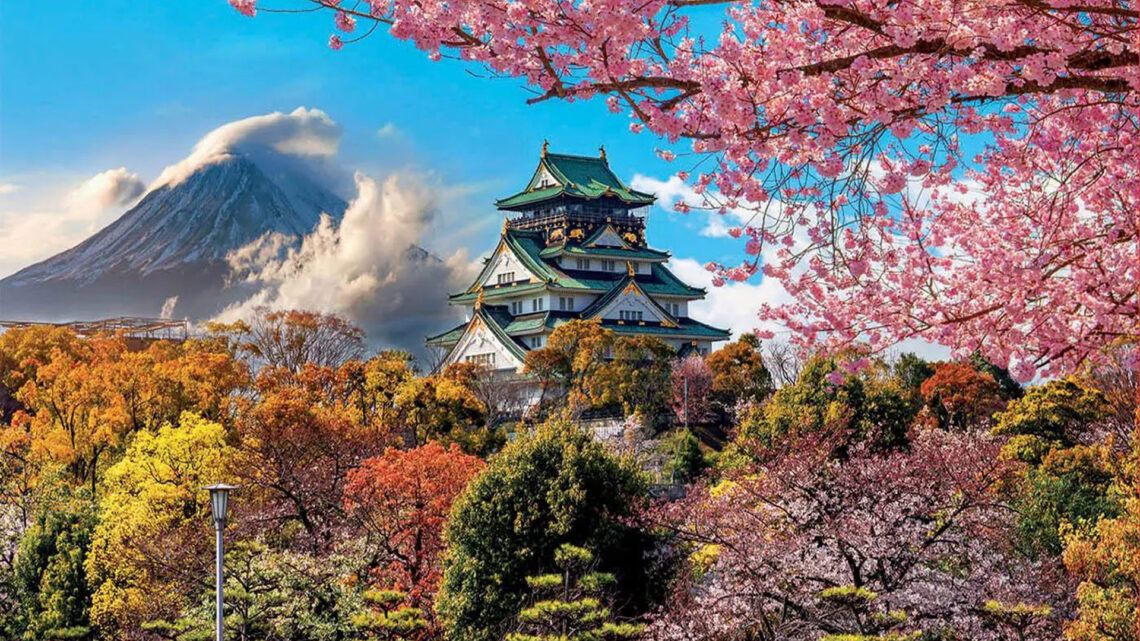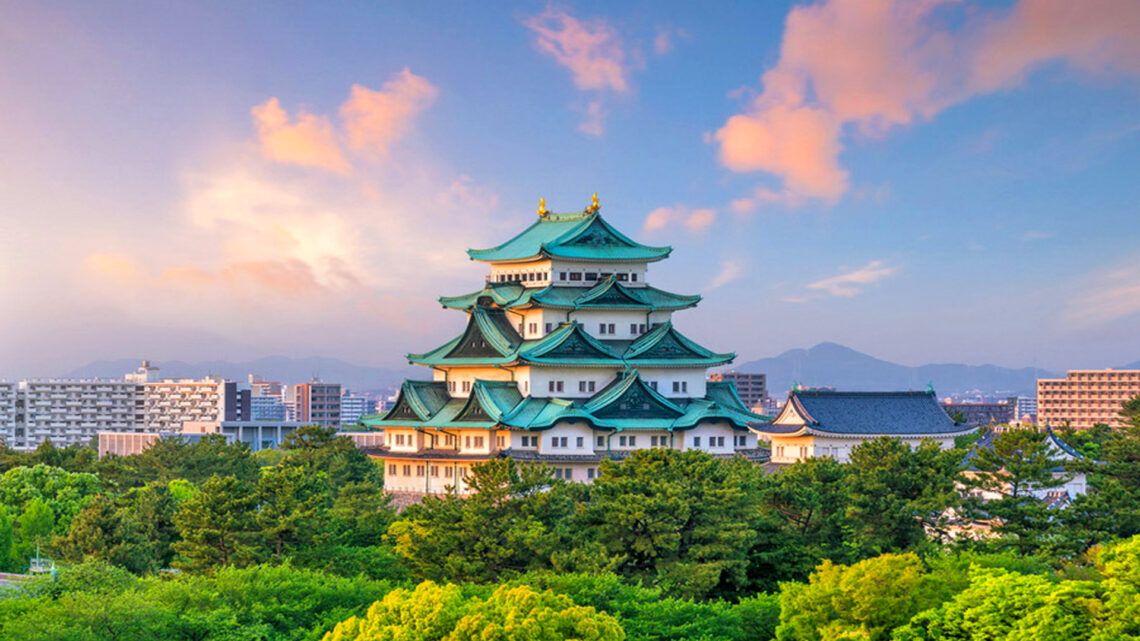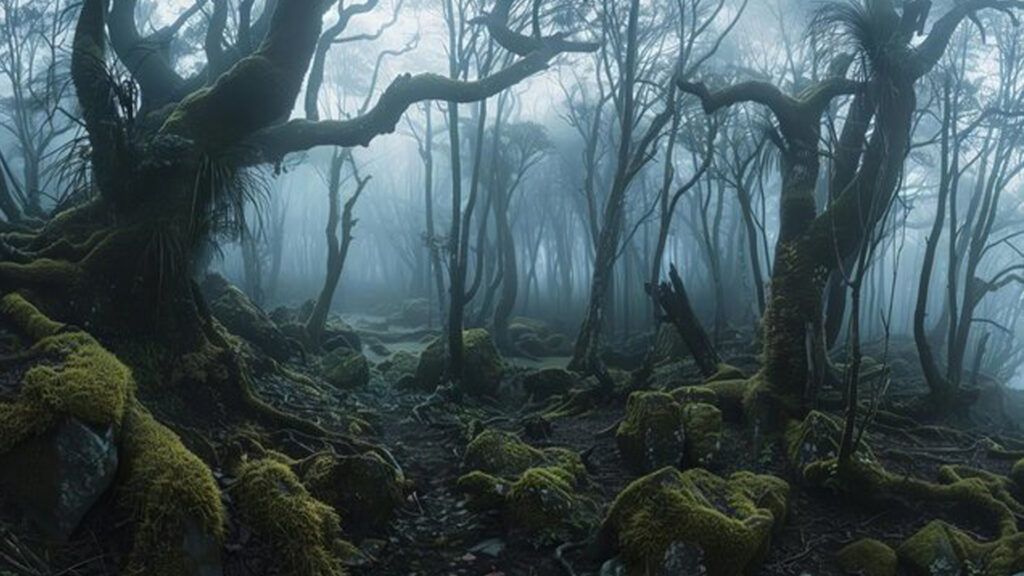
When discussing mysterious places in Japan, one cannot avoid mentioning Aokigahara Forest. Also known as the “Suicide Forest,” Aokigahara is a dense woodland located at the northwestern base of Mount Fuji. Covering about 35 square kilometers, the forest is known not only for its natural beauty but also for the tragic history that surrounds it. Aokigahara is one of the most well-known places in the world where people end their lives. The mystique of the forest, combined with its tragic notoriety, has brought it into the spotlight in media, films, and literature.
Geologically, Aokigahara Forest is unique. It lies on an ancient lava plain formed by a Fuji eruption about 1,100 years ago. The lava has hardened the soil, making it particularly barren, which has contributed to the dense vegetation. With its thick canopy and winding undergrowth, it is easy to lose one’s way in the forest. The forest floor is covered with moss and plants that have adapted to the nutrient-poor volcanic soil. Beneath the surface are numerous caves, created by volcanic activity. The Ice and Wind Caves, in particular, attract tourists. While the forest has a grim reputation, many are drawn to its natural beauty.
Aokigahara has garnered global attention due to the high number of suicides committed there. Historical reports indicate that people have been going to the forest to end their lives since the 19th century. There may be a cultural connection to this phenomenon found in ancient Japanese legends and practices.
During the Edo period (1603–1868), in times of extreme poverty and famine, it is said that elderly or sick family members were abandoned in the forest to die—a practice known as ubasute. Although there is no concrete evidence linking this practice specifically to Aokigahara, it may have contributed to the forest’s current reputation.
In modern times, Aokigahara gained a new kind of fame with the publication of a 1960 book by Seicho Matsumoto. In “Kuroi Jukai,” the author tells the story of two lovers who go to the forest to commit suicide together. This work may have solidified the forest’s association with suicide in modern Japanese culture.
Why this forest? Many have asked this question. Experts agree that the reasons are complex, often rooted in deep layers of Japanese culture, as well as personal crises, economic pressure, or societal stress.
Japan has one of the highest suicide rates in the world, partly due to the immense social pressure many people feel. Aokigahara provides an isolated and seemingly peaceful setting where individuals can contemplate their thoughts without interruption. The quietness of the forest, its remote location, and the sense of being lost can have a profound impact on those in crisis.
Another factor is the anonymity the forest offers. Unlike urban areas or well-known landmarks, one can remain unnoticed in Aokigahara, which may appeal to those who wish to end their lives privately, without interference.
Given the forest’s tragic notoriety, the Japanese government, along with local authorities and non-profit organizations, has implemented measures to discourage suicide. Signs have been placed along the paths, reminding visitors that life is precious and offering help.
One of the most famous signs reads: “Your life is a gift from your parents.” It urges those contemplating suicide to seek help and contact the police. Suicide prevention hotline numbers and other resources are also prominently displayed. These efforts have helped raise awareness of the issue, although the forest remains a known site for suicides.
The intention behind these messages is to reach people in acute crisis who may still be undecided. These emotional appeals often serve as a last barrier, reminding people that help is available and that life is valuable.
In addition to the signs, regular patrols are conducted by volunteers, forest workers, and police officers who search the forest to find individuals who may be at risk. These patrols look for signs of distress or isolation and try to persuade those they encounter to seek help. The presence of patrols has saved some lives.
Alongside rescue efforts, these patrols also face the somber task of searching for those who have already passed away. The volunteers who participate in these patrols are often specially trained to handle such difficult situations with care and respect for the deceased.
In Japan, various emergency hotlines are available 24/7 to support individuals in crisis. These hotlines are often listed on signs in the forest, targeting those who see no other option but to end their lives.
Additionally, many non-profit organizations in the region offer psychological counseling and support. These organizations aim to work both preventively and in response to immediate crises, providing easily accessible services.
Another key aspect of prevention efforts is collaboration with the local community. People who live near or work in Aokigahara are encouraged to be alert to potential warning signs. Hotel staff, taxi drivers, and even local shop owners have been trained to recognize signs of emotional distress and guide individuals to help if needed.
This community initiative is a crucial factor in creating a support network around the forest, helping to break the cycle of despair and isolation.
Despite, or perhaps because of, its grim reputation, Aokigahara Forest remains a popular destination for tourists. Many visitors come out of curiosity, but also to admire the forest’s natural beauty. There are official hiking trails that lead through the forest, offering views of the caves and Mount Fuji.
However, increasing tourism has brought challenges. Some visitors behave disrespectfully by leaving litter in the forest or wandering off the trails in search of morbid discoveries. Authorities have taken measures to protect the environment while also preserving the privacy of those who visit the forest for more peaceful reasons.
Possible Causes of the Suicide Phenomenon in Aokigahara Forest
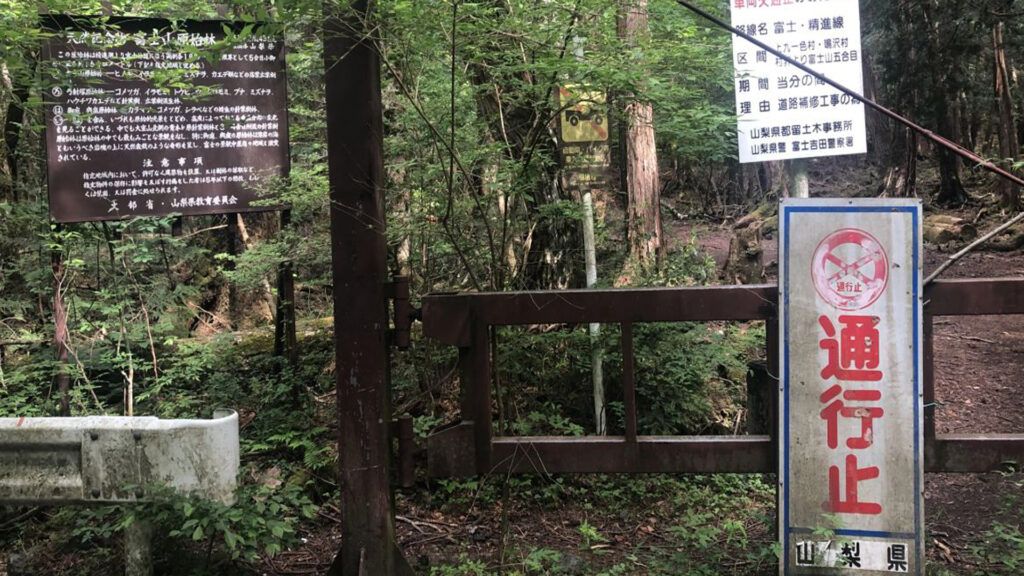
The suicide phenomenon in Aokigahara Forest is deeply rooted in Japan’s social, cultural, and psychological structures. The reasons why people choose this forest as the site for their final act are complex and varied. There is no simple explanation, but a combination of factors—including societal pressure, personal crises, and historical and cultural influences—contribute to this tragic reality.
Historically, economic downturns have often been linked to rising suicide rates in Japan. In times of high unemployment or after financial bubbles burst, many individuals, in a state of desperation, choose suicide as a way to escape debt or avoid burdening their families. In such cases, Aokigahara offers not only a secluded location but also a symbolic retreat from a world they can no longer cope with.
Despite its densely populated urban centers, Japan is a society where loneliness is widespread. Particularly at risk are the elderly who live alone, as well as younger individuals who feel alienated from society. In recent decades, urbanization has led to many people in Japan living in anonymous, isolated conditions. This affects not only individuals in large cities but also those in more rural areas.
A phenomenon often mentioned in connection with social isolation is Hikikomori—people who voluntarily withdraw from society and lead reclusive lives. This isolation often leads to mental health issues such as depression, which, in turn, increases the risk of suicide. In such cases, Aokigahara Forest may be chosen as a final refuge where individuals can end their loneliness in the forest’s quiet seclusion.
Cultural and historical factors also play a significant role in Japan’s high suicide rate. The ritual suicide of Seppuku, practiced by samurai in feudal Japan, remains a powerful symbol in Japanese culture. Although Seppuku was an honorable form of suicide used to avoid disgrace, the act of suicide has been accepted to some extent in Japanese history—a mindset that persists in parts of society today.
This historical background may contribute to the fact that suicide in Japan is often less of a taboo subject compared to other cultures. Suicide is frequently explored in Japanese literature and pop culture, which may lead to a certain normalization of the topic. Due to its isolated location and historical associations with death and loss, Aokigahara Forest has assumed a unique place in Japan’s cultural perception.
As in many countries, mental health disorders such as depression, anxiety, and schizophrenia are key factors that drive people to suicide in Japan. Many individuals who visit Aokigahara Forest suffer from untreated or inadequately treated mental illnesses. The stigma surrounding mental health issues is still widespread in Japan, which can prevent people from seeking professional help.
For many people who enter Aokigahara, the forest is not only a physical place but also a symbolic space for retreat and calm. The dense trees and the absence of sound have a calming effect, attracting those who are internally distressed and desperate. The forest provides an opportunity to disconnect from the world, and it almost feels like a natural boundary between life and death.
Another significant aspect is the anonymity the forest offers. People who have decided to end their lives see Aokigahara as a place where they can die in solitude without being disturbed by the outside world. This anonymity is particularly appealing to those who do not want their act to be immediately discovered or publicly exposed.
Possible Origins of the “Suicide Forest” Myth
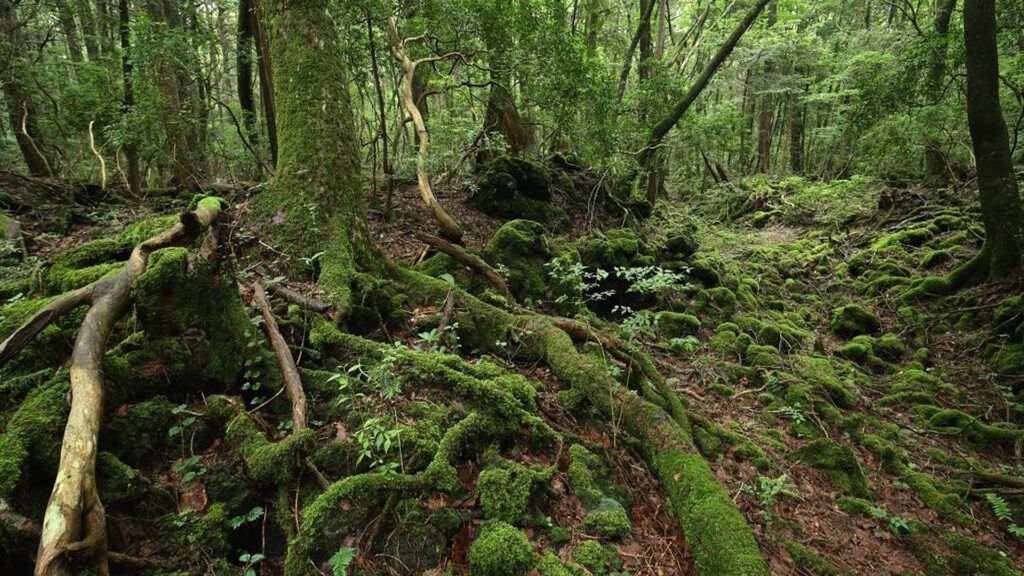
Aokigahara Forest, also known as “Jukai” (Sea of Trees), has been the subject of myths, legends, and tragic stories for many years. These legends are deeply rooted in Japanese folklore and have shaped the forest’s dark reputation as the “Suicide Forest” over time. But how did Aokigahara gain such a grim reputation?
One of the earliest legends associated with Aokigahara Forest is the practice of Ubasute. This old and now-debunked story claims that during times of extreme hardship and famine, elderly or sick people were taken by their families into the forest and left there to die. The term Ubasute literally means “abandoning an old woman” and refers to the supposed practice of discarding family members to conserve scarce resources.
Although there is no reliable evidence that Ubasute was actually practiced in Aokigahara Forest, the legend is strongly entrenched in Japanese folklore. This story may have contributed early on to the forest being viewed as a place of death and abandonment, cementing its dark reputation.
Another source of the “Suicide Forest” myth lies in modern Japanese literature. Notably, the book Kuroi Jukai (Black Sea of Trees) by Japanese author Seicho Matsumoto, published in 1960, played a significant role in spreading the myth. In the novel, one of the main characters commits suicide in Aokigahara Forest, bringing the image of the forest as a place for suicide into the consciousness of readers.
The book not only generated increased media attention but also influenced public perception of Aokigahara Forest. It is often believed that the novel inspired imitators, further linking the forest to suicides—a connection that endures to this day.
Another factor contributing to the popularity of the myth was the publication of the controversial book The Complete Suicide Manual (Kanzen Jisatsu Manyuaru) by Wataru Tsurumi in 1993. This book, which discusses various methods of suicide, mentioned Aokigahara Forest as one of the “best places” for suicide in Japan. Although the book was heavily criticized, it increased attention to the forest and possibly led to a rise in suicide cases there.
The book became especially popular among teenagers and young adults, further cementing the myth. The mention of Aokigahara Forest in such a controversial book significantly contributed to its public perception as the “Suicide Forest.”
In addition to literary and societal influences, numerous supernatural legends surround Aokigahara Forest. In Japanese folklore, ghosts and spiritual beings play an important role, and there are countless stories about Yurei—the restless spirits of the dead—who have entered Aokigahara Forest. It is believed that these spirits, trapped in the world of the living by unfinished business or violent deaths, roam the forest.
These legends have evolved over centuries and continue to contribute to the forest’s mystical and eerie aura. Many believe that people who die in Aokigahara Forest continue to exist as Yurei, luring the living into the forest or leading them astray. These ghost stories amplify the forest’s dark atmosphere, making it a place of misfortune in Japanese culture.
Aokigahara Forest itself also adds to its mystical reputation. The unusually dense vegetation, the absence of typical forest sounds due to the lava formations, and the winding paths that easily lead people astray create a claustrophobic and oppressive atmosphere. There are no visible animals, the typical sounds of a forest are largely absent, and the thick trees block the wind, making the forest eerily silent.
These geological features make it easy to get lost in the forest, which has also led to legends of lost souls and restless spirits. The fact that electronic devices like compasses and GPS often malfunction due to the magnetic properties of the ground enhances the belief that the forest possesses some kind of “uncanny power” that disorients people.
Another key factor in the myth of Aokigahara Forest is the role of modern media and the internet. In recent decades, national and international coverage of the forest has increased. Documentaries and reports about the high suicide rates in the forest have made it known beyond Japan as the “Suicide Forest.”
The internet has played a significant role in spreading the myth. Online forums, social media, and blogs have allowed stories and legends about the forest to circulate quickly. This has had both positive and negative effects. On one hand, there are initiatives focused on suicide prevention and helping those in need. On the other hand, there is a morbid fascination fueled by these stories, attracting people to the forest out of curiosity.
The origins of the Aokigahara “Suicide Forest” myth are multifaceted, ranging from historical legends and cultural and literary influences to modern media coverage. The forest is a unique place that plays a special role in Japanese culture due to its natural characteristics, its history, and the mystical narratives that surround it. The myth of the “Suicide Forest” is the result of a combination of factors that together tell a tragic yet fascinating story.
Getting to Aokigahara Forest and Nearby Accommodations
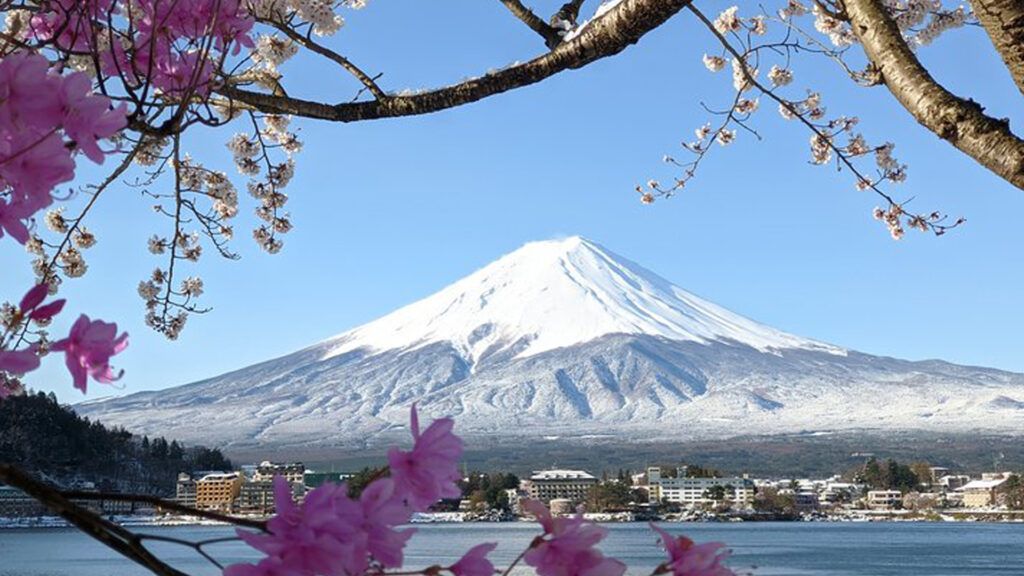
Aokigahara Forest, located at the base of Mount Fuji, Japan’s highest and most renowned mountain, is a readily accessible destination for visitors. Beyond its somber reputation as the “Suicide Forest,” it also attracts tourists interested in exploring its unique natural beauty and geological features. For travelers planning to visit, there are various transportation options and numerous accommodations in the surrounding area.
The Fuji region is relatively accessible from Japan’s major cities such as Tokyo, Yokohama, and Osaka. Aokigahara Forest is situated in Yamanashi Prefecture, about 100 kilometers west of Tokyo. Various transportation methods can be used to reach the area, with most routes ending near Kawaguchiko, a popular spot at the foot of Mount Fuji.
By Train
One of the most convenient and popular ways to reach Aokigahara Forest is by train. Visitors can take the JR Chuo Line from Tokyo to Otsuki Station, where they can transfer to the Fujikyu Line to reach Kawaguchiko Station. The entire journey from Tokyo to Kawaguchiko takes about two hours and offers picturesque views of Mount Fuji.
For international tourists using the Japan Rail Pass, this route is particularly attractive as the pass covers much of the journey. From Kawaguchiko, buses are available that bring visitors close to Aokigahara Forest. These buses also serve other attractions around Fuji, such as the Fuji Five Lakes region and the famous Pagoda Monument.
By Bus
For a more budget-friendly alternative, visitors can travel directly from Tokyo to Kawaguchiko by bus. Buses frequently depart from central bus terminals like the Shinjuku Expressway Bus Terminal. There are direct express buses that run regularly to Kawaguchiko, with the journey taking about two to two and a half hours.
From Kawaguchiko, visitors can take a local bus or taxi to the entrance of Aokigahara Forest. Local buses run at regular intervals and stop at various popular entry points of the forest, such as the Narusawa Ice Cave Museum parking lot, where hikes through the forest can begin.
By Car
Another option is to drive. Renting a car or using a personal vehicle allows for quick access to the Fuji region via the Chuo Expressway or Tomei Expressway from Tokyo. The drive takes about one and a half to two hours, depending on traffic conditions. Parking is available around Aokigahara Forest, especially near hiking trails and tourist attractions such as the lava caves and lakes.
Guided Tours
For those who prefer to experience Aokigahara Forest as part of a guided tour, several operators offer tours from Tokyo or Kawaguchiko. These tours often include visits to other attractions around Fuji, making them a good option for travelers who want to see as much as possible in a short time. Guided tours provide additional information about the forest’s geology, flora, fauna, and the history of the area.
Accommodations Around Aokigahara Forest

The Fuji region offers a range of accommodations, from simple guesthouses to luxurious hotels. Many visitors stay in Kawaguchiko or Fujiyoshida, the nearest towns ideal for day trips to the forest and Mount Fuji.
Ryokan – Traditional Japanese Inns
For an authentic experience, there are numerous ryokan (traditional Japanese inns) in the region. Ryokan typically feature tatami mat rooms, communal hot springs (onsen), and traditional multi-course dinners. They offer a tranquil and relaxing atmosphere, perfect for unwinding after a day in nature.
Notable ryokans in the region include Fuji Ginkei in Kawaguchiko and Konansou, both offering stunning views of Mount Fuji. Many of these accommodations are near the Five Lakes, which are picturesque and appealing to nature lovers.
Hotels and Guesthouses
For travelers preferring more modern accommodations, there are numerous hotels and guesthouses in the area. Kawaguchiko offers a wide range of lodging options, from budget hotels to luxury hotels with views of Mount Fuji.
One of the popular hotels in the area is Hotel Mystays Fuji Onsen Resort, which features modern rooms and an onsen with views of the mountain. Nearby, there are also many smaller guesthouses and inns that offer a more intimate and often more affordable lodging experience.
Campgrounds
For nature enthusiasts, camping near Aokigahara Forest is also an option. The Fuji region is known for its scenic campgrounds, suitable for both tent camping and RVs. One of the most well-known campgrounds is Fujikawaguchiko Campground, located right on Lake Kawaguchi and offering spectacular views of Mount Fuji.
Campgrounds are especially popular among locals and tourists wanting to experience nature up close while exploring the area around Aokigahara Forest. Many campgrounds also provide amenities like grilling facilities and basic services such as showers and toilets.
Attractions Near Aokigahara Forest
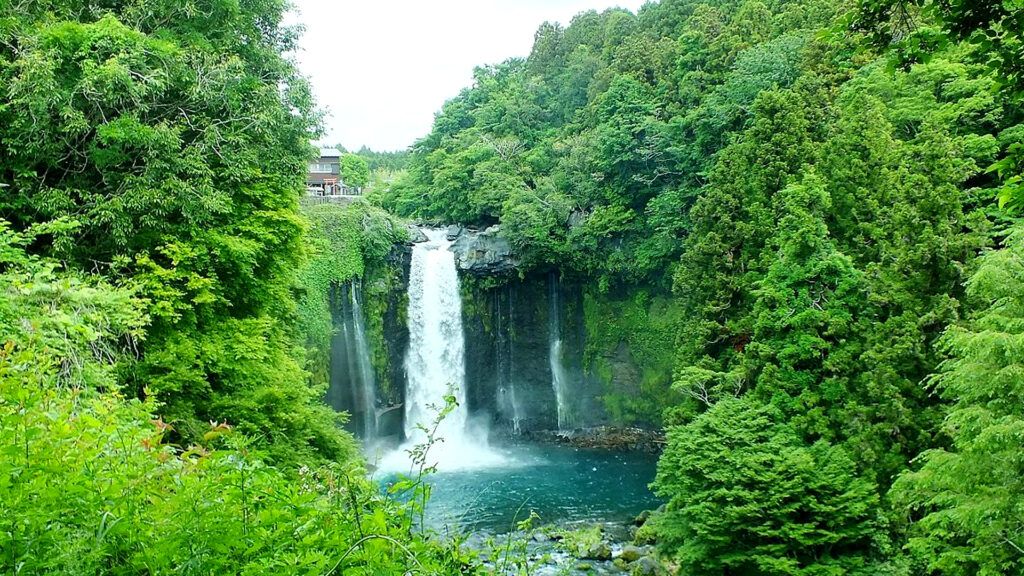
In addition to Aokigahara Forest, there are many other attractions worth visiting in the area. Notably, the Fuji Five Lakes region offers stunning views of Mount Fuji and a variety of activities such as boating, hiking, and fishing.
Among the prominent attractions nearby are the Narusawa Ice Cave, a fascinating lava cave covered in ice year-round, and the Fugaku Wind Cave, another lava cave open for exploration. Both caves are located on the edge of Aokigahara Forest and are easily accessible on foot.
Traveling to Aokigahara Forest is straightforward for both international and domestic travelers. With its proximity to major cities and well-developed tourism infrastructure around Mount Fuji, there are many options for visiting the area while enjoying the natural surroundings. Whether opting for a traditional ryokan, a modern hotel, or a campground, the region offers accommodations to suit all preferences and budgets.
My Conclusion

Suicide has a long, complex cultural and historical connection in Japan. Historically, the act of suicide, especially in the form of seppuku (ritual suicide), played a significant role in the country. Seppuku was considered an honorable act to avoid disgrace or restore honor.
Although seppuku is no longer practiced today, societal pressure in Japan remains very high. Success and failure are often viewed in extreme terms, and the loss of honor or the feeling of being a burden can lead many individuals to contemplate suicide. These cultural roots may contribute to Japan’s persistently high suicide rates.
Aokigahara Forest is both a fascinating and tragic place. It uniquely combines the natural beauty of an ancient forest with the grim realities that stem from social and psychological challenges. While the forest is known for its scenic and geological uniqueness, it remains a symbol of deeply rooted societal issues that drive people to despair.
It is important to approach Aokigahara Forest with respect and awareness. The forest not only tells a story of sorrow and loss but also reflects the human need to be heard and seek help. Despite its somber reputation, there is still hope and the possibility of saving lives, whether through direct preventive measures or a deeper understanding of the psychological and cultural backgrounds that lead people to this place.
Suicide Prevention and Support Services
If you or someone you know is contemplating suicide, there are support services available in many countries. Suicide is a serious matter, and it is crucial to talk about it and seek help.


